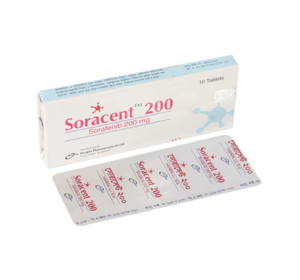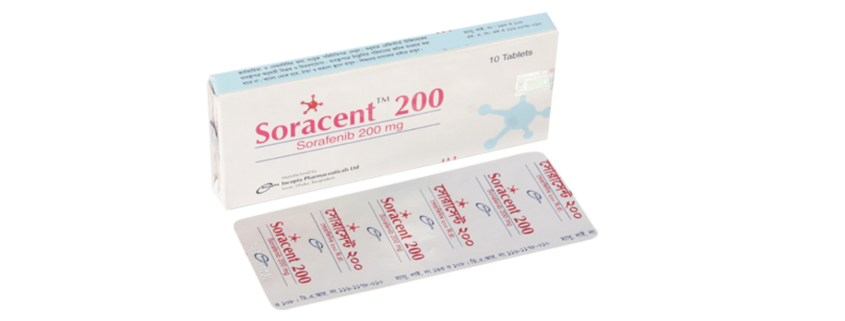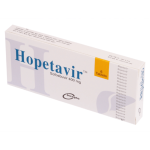Soracent(Sorafenib)

Therapeutic Group: Oncology
Presentation
Soracent 200: Each tablet contains Sorafenib Tosylate INN equivalent to Sorafenib 200 mg
Description
Sorafenib is a kinase inhibitor that decreases tumor cell proliferation in vitro. Sorafenib was shown to inhibit multiple intracellular (CRAF, BRAF, and mutant BRAF) and cell surface kinases (KIT, FLT-3, RET, VEGFR-1, VEGFR-2, VEGFR-3, and PDGFR-ß). Several of these kinases are thought to be involved in tumor cell signaling, angiogenesis, and apoptosis. Sorafenib inhibited tumor growth and angiogenesis of human hepatocellular carcinoma and renal cell carcinoma, and several other human tumor xenografts in immunocompromised mice.
Indications
Sorafenib is a kinase inhibitor indicated for the treatment of Unresectable hepatocellular carcinoma, advanced renal cell carcinoma and locally recurrent or metastatic, progressive, differentiated thyroid carcinoma (DTC) refractory to radioactive iodine treatment
Dosage & Administration
400 mg (2 tablets) orally twice daily without food
• Treatment interruption and/or dose reduction may be needed to manage suspected
adverse drug reactions. Dose may be reduced to 400 mg once daily or to 400 mg every 2
day.
Side Effects
The most common adverse reactions (≥20%), which were considered to be related to Sorafenib, are fatigue, weight loss, rash/desquamation, hand-foot skin reaction, alopecia,
diarrhea, anorexia, nausea and abdominal pain
Precautions
• Cardiac ischemia and/or infarction may occur. Temporary or permanent discontinuation of Sorafenib should be considered
• Bleeding may occur. If bleeding necessitates medical intervention, discontinuation of Sorafenib should be considered
• Hypertension usually occurred early in the course of treatment and was managed with antihypertensive therapy. Blood pressure should be monitored weekly during the first 6 weeks and periodically thereafter and treated, as required
• Hand-foot skin reaction and rash are common. Management may include topical therapies for symptomatic relief, temporary treatment interruption and/or dose modification, or in severe or persistent cases, permanent discontinuation
• Gastrointestinal perforation is an uncommon adverse reaction. In the event of gastrointestinal perforation, Sorafenib therapy should be discontinued
• Temporary interruption of Sorafenib therapy is recommended in patients undergoing major surgical procedures
• Caution is recommended when co-administering substances metabolized/eliminated predominantly by the UGT1A1 pathway (for example, Irinotecan)
• Caution is recommended when co-administering Docetaxel
• Caution is recommended when co-administering Doxorubicin
• Sorafenib may cause fetal harm when administered to a pregnant woman. Women of childbearing potential should be advised to avoid becoming pregnant while on Sorafenib
Impairment of TSH suppression in DTC: TSH should be monitored monthly and thyroid replacement therapy should be adjusted in patients with thyroid cancer.
Use in Pregnancy & Lactation
Pregnancy Category D
Based on its mechanism of action and animal data, Sorafenib can cause fetal harm when administered to a pregnant woman. There are no available data on Sorafenib use in pregnant women. Pregnant women should be advised of the potential risk to a fetus. It is not known whether Sorafenib is excreted in human milk. Because many drugs are excreted in human milk and because of the potential for serious adverse reactions in nursing infants from Sorafenib, a decision should be made whether to discontinue nursing or to discontinue the drug, taking into account the importance of the drug to the mother.
Pediatric Use
The safety and effectiveness of Sorafenib in pediatric patients have not been established.
Geriatric Use
No differences in safety or efficacy were observed between older and younger patients, and other reported clinical experience has not identified differences in responses between the elderly and younger patients, but greater sensitivity of some older individuals cannot be ruled out
Drug Interaction
• Carboplatin and Paclitaxel: Caution, Sorafenib and Paclitaxel AUC increases when
co-administered
• UGT1A1 (for example, Irinotecan) and UGT1A9 substrates: Caution, drug AUC increases
when co-administered with Sorafenib
• Docetaxel: Caution, Docetaxel AUC increases when co-administered with Sorafenib
• Doxorubicin: Caution, Doxorubicin AUC increases when coadministered with Sorafenib
• Fluorouracil: Caution, fluorouracil AUC changes when coadministered with Sorafenib
• CYP2B6 and CYP2C8 substrates: Caution, systemic exposure is expected to increase
when co-administered with Sorafenib
• CYP3A4 inducers: Expected to increase metabolism of Sorafenib and decrease Sorafenib concentrations
• Neomycin: Caution, Sorafenib AUC decreases when coadministered with oral neomycin
Commercial Pack
Soracent 200: Each box contains 3 blister strips of 10 tablets



